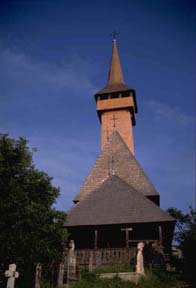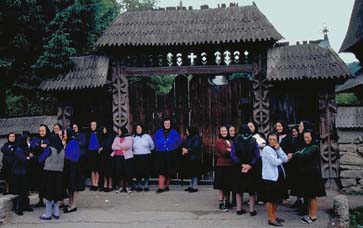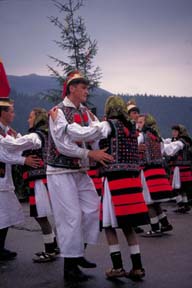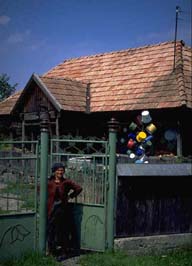The Iza Valley
The Iza Valley follows the Iza river from Sighet Marmatiei, 37 miles (60 km.) to its source in the Rodna Massif. The valley is lined with small villages where daily life has not changed for centuries. They are famous for their old hand-built houses, elaborately carved gates and tall wooden churches. When not at work in the fields or at home, the villagers like to sit on the benches of their fancy carved gates to socialize, and on Sundays everyone promenades along the streets.
Vadu Isei, the first village south of Sighet, has a tourism information office where you can buy maps of the region, crafts or hire a local guide for the day to show you the wooden churches and weaving workshops. They also arrange overnight accommodation in private homes.
 At Nanesti and Birsana, the carved gates and churches begin to appear.
At Nanesti and Birsana, the carved gates and churches begin to appear.
Strimtura was the site of a battle against the Tatars in 1717.
Rozavlea's church was made of fir tree trunks, also in 1717.
Botiza's wooden church is next to the new church and local priest's house. His wife revived the original vegetable dyes and design motifs of Maramures' traditional carpets. The village has a tiny mill where the rug weaving takes place.
Ieud village, on the Ieud river, is home of the most famous wooden churches in the valley. The Church on the Hill dates from 1364 and contains 15th and 16th century paintings. The lower church was built in 1718.
Bogdan Voda, is the birthplace of the first ruler of Moldavia, Bogdan I, who in 1359 led a revolt against the Hungarians. Its wooden church there dates from 1722.
 All of the old wooden churches are very small inside (women must stand outside if the service gets too crowded with men), but their high shingled steeples seem to point toward the heavens. The craftmanship of these centuries-old buildings is evident in the cantilevered joints and wood-peg nails holding it together.
All of the old wooden churches are very small inside (women must stand outside if the service gets too crowded with men), but their high shingled steeples seem to point toward the heavens. The craftmanship of these centuries-old buildings is evident in the cantilevered joints and wood-peg nails holding it together.
The skill of the local wood carvers is displayed on large wooden gates with intricate designs that have symbolic meanings.
Dragonmiresti, Salistea de Sus and Sacel are the last three villages in Iza Valley.
At Sacel, a route north leads into the foothills of the Rodna massif.
Return to top
The Viseu Valley
 The Viseu Valley runs parallel to the Iza Valley, but farther north, along the Viseu river, extending from Sighet to the Prislop Pass at the eastern border of Maramures county. Trains from Sighet run through this valley to Viseu de Jos, where an eastward branch continues as far as Borsa.
The Viseu Valley runs parallel to the Iza Valley, but farther north, along the Viseu river, extending from Sighet to the Prislop Pass at the eastern border of Maramures county. Trains from Sighet run through this valley to Viseu de Jos, where an eastward branch continues as far as Borsa.
Borsa has a hotel, as well as an 18th century wooden church. Seven miles farther east, is the Borsa Turist Complex, a spa and ski resort with a hotel and chalets. North of the complex is Prislop Pass, a 4,645 ft. (1,416 m.) corridor between the Maramures mountains to the north and the Rodna mountains to the south. This is a beautiful area for hiking through the Rodnas and the site of the annual Hora la Prislop festival.
Much of the Viseu valley is uncharted, but explorers who venture into the fir, spruce, oak and beech forests may see bears, stags, roebucks, wild boar, chamois and mountain cocks. There are also glacier lakes, waterfalls, volcanic mountains, caves and the geological reserve Creast Cocoslui, or Cock's Comb.
Traveling northeast, back towards Sighet, you pass through Borsa and Moisei, to Viseu de Sus, which has a small hotel. In the morning an old steam engine hauls lumberjacks up the Vaser Valley to their camps farther north, and returns them to town in the late afternoon.
Viseu de Jos, is the next village east, then Ruscova, and then Leordina and Petrova, picturesque villages known for folk costumes and architecture.
The road continues to the Ukranian border, then cuts south to Tisa where there's a private museum in the Pipas family house with a collection of glass & wood icons, pottery, woven fabrics, coins, paintings, sculptures and hand-woven rugs. Sighet is just 2 miles farther east.

Return to top
 A World of Adventure
A World of Adventure  A World of Adventure
A World of Adventure